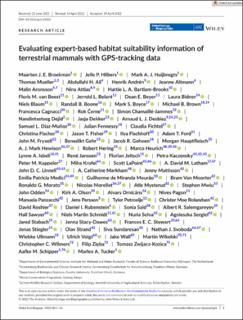Evaluating expert-based habitat suitability information of terrestrial mammals with GPS-tracking data
Broekman, Maarten J. E.; Hilbers, Jelle P.; Huijbregts, Mark A. J.; Mueller, Thomas; Ali, Abdullah H.; Andrén, Henrik; Altmann, Jeanne; Aronsson, Malin; Attias, Nina; Bartlam-Brooks, Hattie L. A.; van Beest, Floris M.; Belant, Jerrold L.; Beyer, Dean E.; Bidner, Laura; Blaum, Niels; Boone, Randall B.; Boyce, Mark S.; Brown, Michael B.; Cagnacci, Francesca; Cerne, Rok; Chamaillé-Jammes, Simon; Dejid, Nandintsetseg; Dekker, Jasja; Desbiez, Arnaud L. J.; Díaz-Muñoz, Samuel L.; Fennessy, Julian; Fichtel, Claudia; Fischer, Christina; Fisher, Jason T.; Fischhof, Ilya; Ford, Adam T.; Fryxell, John M.; Gehr, Benedict; Goheen, Jacob B.; Hauptfleisch, Morgan; Hewison, A. J. Mark; Hering, Robert; Heurich, Marco Dietmar; Isbell, Lynne A.; Janssen, René; Jeltsch, Florian; Kaczensky, Petra; Kappeler, Peter M.; Krofel, Miha; LaPoint, Scott; Latham, A. David M.; Linnell, John Durrus; Markham, A. Catherine; Mattisson, Jenny; Medici, Emilia Patricia; Van Moorter, Bram; Mysterud, Atle; Odden, John; Panzacchi, Manuela; Rolandsen, Christer Moe; Strand, Olav
Peer reviewed, Journal article
Published version
Date
2022Metadata
Show full item recordCollections
Original version
10.1111/geb.13523Abstract
Aim: Macroecological studies that require habitat suitability data for many species often derive this information from expert opinion. However, expert- based informa-tion is inherently subjective and thus prone to errors. The increasing availability of GPS tracking data offers opportunities to evaluate and supplement expert- based in-formation with detailed empirical evidence. Here, we compared expert- based habitat suitability information from the International Union for Conservation of Nature (IUCN) with habitat suitability information derived from GPS-tracking data of 1,498 individu-als from 49 mammal species.Location: Worldwide.Time period: 1998–2021.Major taxa studied: Forty- nine terrestrial mammal species.Methods: Using GPS data, we estimated two measures of habitat suitability for each individual animal: proportional habitat use (proportion of GPS locations within a habi-tat type), and selection ratio (habitat use relative to its availability). For each individual we then evaluated whether the GPS- based habitat suitability measures were in agree-ment with the IUCN data. To that end, we calculated the probability that the ranking of empirical habitat suitability measures was in agreement with IUCN's classification into suitable, marginal and unsuitable habitat types.Results: IUCN habitat suitability data were in accordance with the GPS data (> 95% probability of agreement) for 33 out of 49 species based on proportional habitat use estimates and for 25 out of 49 species based on selection ratios. In addition, 37 and 34 species had a > 50% probability of agreement based on proportional habitat use and selection ratios, respectively.Main conclusions: We show how GPS-tracking data can be used to evaluate IUCN habitat suitability data. Our findings indicate that for the majority of species in-cluded in this study, it is appropriate to use IUCN habitat suitability data in macro-ecological studies. Furthermore, we show that GPS-tracking data can be used to identify and prioritize species and habitat types for re-evaluation of IUCN habitat suitability data. expert opinion, GPS, habitat suitability, habitat type, habitat use, IUCN, mammals, movement, selection ratio, telemetry

